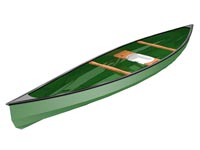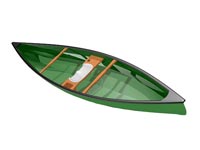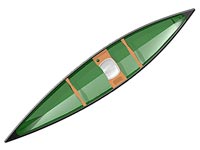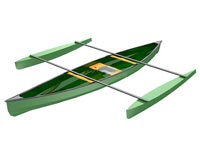Big Time Adventures
in a Beautiful Boat
Specifications:
|
|
Length |
- |
15' |
Width |
- |
30" |
Draft @ 280 lbs. |
- |
3.8" |
Weight (estimated) |
- |
42 lbs. |
Rocker-bow |
- |
2.3" |
Rocker-stern |
- |
1.8" |
Right up front, I’m going to provide the full
tip of the cap to John Winters, Canadian boat designer,
for the inspiration to design this particular canoe.
John’s Osprey II S&G design is a beautiful
example of a designer bringing his enormous skills
to the worktable. I wanted to draw a solo, tripping
style canoe for 4mm marine plywood construction, so
I took a long look at the Osprey to see if there was
anything I could do differently with the form.
 |
Right up front,
I’m going to provide the full tip of the
cap to John Winters, Canadian boat designer,
for the inspiration to design this particular
canoe. |
In Winters’ design, there is a very nice, tumblehome
chine along the shear to give additional paddle stroke
clearance. I have built boats before that used a similar
tumblehome panel and it turns out that they can give
the builder some interesting problems when it comes
to constructing the hull.
This tumblehome chine is very slender in width, which
requires the builder to have a reasonable set of skills
to wire it in place prior to filleting or they will
end-up with a potentially wavy hull section that just
won’t go away short of doing it over. Since
I was looking to draw the Bighorn for easier construction
for the average guy, I decided to drop the tumblehome
panel and instead raise the outer hull panel to maintain
freeboard. The result is a six panel hull that is
easy to build and nice looking.
| The hull shape is
asymmetric in form with the widest point (and
it’s center of buoyancy) just aft of the
hulls’ midpoint. |

|
The hull shape is asymmetric in form with the widest
point (and it’s center of buoyancy) just aft
of the hulls’ midpoint. The hull also has decidedly
enhanced rocker fore and aft when compared to traditional
canoes of this size. These two design features give
the boat very solid, straight-line tracking, as well
as wonderful response to turning stroke input from
the paddler.
At full, 350-lb. displacement load, the Bighorn has
just less than 8” of freeboard amidships. I
don’t see this kind of load in this boat unless
the owner is going out for a very long solo trip and
needs to carry a lot of gear. More likely, you’ll
be seeing an all-up, ready for trouble, load of around
290-300 pounds, depending on the weight of the paddler.
I figure this boat can be built at right around 42
pounds, providing the guy with the resin doesn’t
get too generous with the glue.
 |
There’s
a comfortable, sculptural sitting area much
like the tractor-style seats one sees on the
Wenonah canoes. |
The seat setup in the renderings illustrates my take
on an integrated unit recognizing the typical canoeists
needs when out paddling. There’s a comfortable,
sculptural sitting area much like the tractor-style
seats one sees on the Wenonah canoes. It is coupled
with an integrated pocket on one side for camera/binocular/etc.
and on the other side… a circular, net bottomed
opening to hold the beverage of your choice. (Ever
had a can of coke tip over in your canoe while paddling
because there was nowhere secure to hold it? Makes
for a fun clean-up session, don’t it?)
If you don’t care for the integrated seating
system, you can always use the traditional, woven
caned seat, a simple, stretched canvas platform or
a woven-webbing seat. For that matter, you could always
buy a tractor seat from Wenonah.
| I drew a set of
outriggers specifically for this boat. They aren’t
fancy in appearance, but they are very simple
to build, easy to use and they provide enormous
stability to the boat |

|
Outside the typical description of a solo canoe introduction,
I decided to include a little extra teaser for those
so inclined. I drew a set of outriggers specifically
for this boat. They aren’t fancy in appearance,
but they are very simple to build, easy to use and
they provide enormous stability to the boat if you’d
like to fish, shoot pictures, take a nap, shoot birds,
etc. And, ssssh! Don’t tell anyone, but they
can also be used with a modest sail rig to allow the
Bighorn to be sailed like a trimaran, though don’t
be expecting these amas, or the suggested sail rig
size of 30 sq. ft., to provide much more than a pleasant
sailing experience. Still, it could be fun on the
right body of water.
Bighorn plans are available from the Duckworks
store for $75. Plans for the seat system
are available for $20 and plans for the amas and mounting
points in the canoe are ready for $50.
Chris Ostlind
Lunada Design
Chris@Wedgesail.com

Articles by Chris Ostlind:
|